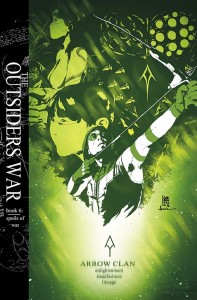Green Arrow #31
Written by Jeff Lemire
Art by Arndrea Sorrentino
Colors by Marcelo Maiolo
Letters by Rob Leigh
Review by Mike Duke
Here’s the thing about cliché: there’s a reason it’s cliché, and the reason is that it works. It works well enough that it’s been used over and over again. We generally think of cliché as bad writing, but it’s really only bad if it’s used incorrectly. So, when I say that The Outsiders War–the second major arc in Jeff Lemire’s amazing takeover of Green Arrow–is cliché, please don’t mistake me. Lemire wields it in a way that makes the story feel familiar and compelling but not distracting. Also, the elements that Lemire uses create an instant sense of drama while also helping the reader care about a rather large cast of characters in a short amount of time. To like Green Arrow is to embrace the cliché, to see it for what it is and not care because the story is still cool and fun and dramatic and so many other things that we are only allowed to get away with in comics.

At this point in the story, I think Oliver speaks for the reader as he expresses his fatigue over the The Outsiders, and his want to just go home. Like the end of any hero’s journey, Oliver is given the choice to stay and lead The Outsiders or leave it all behind, and he doesn’t really blink before walking away except to let them know that he won’t be kind if they turn up on his turf. I’m sure this is not the last we’ve seen of The Outsiders, but it’s nice to think that after six issues, we will get a break from them for a while.
Much of the reason to read Green Arrow lies in the art. While the story may seem like something you’ve seen a million times, the way that Andrea Sorrentino and Marcelo Maiolo put together this book is genuinely unique. What Sorrentino understands so well is that this isn’t Superman—Green Arrow doesn’t punch the bad guy and make him fly 30 feet before smashing into a wall. These are people who have the strength of regular people, and so when they fight, an action that may turn the tide of battle could be subtle. And so, what Sorrentino does is he frames and highlights those subtle moments, often within the larger frame of the battle, and then Maiolo comes in and colors these frames differently—most often by leaving the figure in black and white while coloring the background red. Sometimes this bleeds into a large panel for effect, but most often it’s the smallest thing: an arrow strike in a critical spot, the appearance of a character from the shadows, an object in the frame that might not seem as important as it is. This technique gives Green Arrow a cinematic quality that I just love looking at, and makes the art even more interesting on multiple readings.
Verdict
Buy it. It might be melodramatic and it might be cliché at times, but Green Arrow is still ultimately fun and eminently readable for those qualities, not despite them. And I’m really not kidding when I say that the art is worth reading the book for, even if the story wasn’t. What Lemire has done is made the character cool, made the universe interesting, and created a story that will also appeal to fans of other media. Oh yeah, and you know that Arrow TV show? If you like that, you’re going to like this too. I have a feeling that there are a good number of Arrow fans who will be getting Outsiders War trade paperbacks in their stockings for Christmas this year.
